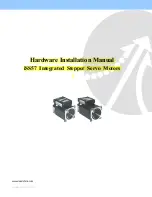
Diagnostics Optimization CT MODBUS RTU Technical Data
154
E300 Design Guide
Issue Number: 1
Open loop, Static autotune: Basic control parameters
This test measures the basic control parameters without moving the motor. A stationary test is performed to measure Stator resistance, Transient
inductance, Maximum deadtime compensation and Current at maximum deadtime compensation as detailed in Table 7-4. Table 7-4 below shows the
parameters required for basic Open loop motor control and indicates which can be set by the user from the motor nameplate and which can be
measured with the static autotune.
Table 7-4 Open loop static autotune parameters
RFC-A, Static autotune: Basic control parameters
This test measures the basic control parameters without moving the motor. A stationary test is performed to measure Stator resistance, Transient
inductance, Maximum deadtime compensation and Current at maximum deadtime compensation as detailed in Table 7-5
. The Stator resistance and Transient inductance are used in RFC-A mode to set up the Current controller P and Current controller I
gains. This is only performed once during the test, and the user can make manual adjustments to the current control loop gains if required for
example where motor acoustic noise is present following an autotune and subsequent operation. Table 7-5 below shows the parameters required for
basic RFC-A motor control and indicates which parameter can be set by the user from the motor nameplate, and which can be measured with the
static autotune.
Table 7-5 RFC-A static autotune parameters
RFC-S Static autotune: Basic control parameters
This test measures the basic control parameters without moving the motor. This test can be used to measure all the necessary parameters for basic
control, however higher performance can be achieved through carrying out a rotating autotune test.
1. A stationary test is performed to locate the flux axis of the motor.
2. The Position feedback phase angle
is set-up for the position from the position feedback interface connected to the drives main interface.
3. A stationary test is performed to measure the
B33
B37
)
4. A stationary test is performed to measure Stator resistance, Maximum deadtime compensation and Current at maximum deadtime compensation.
5. The Stator resistance and
(
B33
) are used to set-up Current controller P and Current controller I Gains. This is only
performed once during the test, the user can make manual adjustments to the current control loop gains if required, for example due to motor
acoustic noise following an autotune and operation.
It should be noted that because this is a stationary test, it is not possible to check the direction of the position feedback. If the motor power connection
phase sequence is incorrect, i.e. the position feedback counts in reverse when the drive applies a phase sequence U-V-W to operate in the forward
direction, then the motor will jump through 90 degrees electrical, and stop with a current in the motor defined by the current limits. This can be
corrected by changing the drive motor phase sequence with
A27
(
Reverse Motor Phase Sequence
B26
), and then repeating the autotune test. This
will ensure that the motor rotates correctly in the direction defined by the position feedback rotation.
If the position feedback direction is correct, the motor will rotate under control in the required direction, but if the position feedback direction is
Parameter
Required for
Detail
A21
B06
)
Basic control
Motor nameplate
A18
)
A22
) Slip
compensation
A19
B03
) Basic
control
B04
)
Not used
A20
(Number Of Motor Poles
B05
)
Basic control
B34
)
Basic control Ur S (0) Ur (1), Ur Auto (3), Ur I (4)
modes
Manually enter, Static or rotating
autotune
(
B33
)
Improved performance
Static or rotating autotune
(
B46
)
Basic control
Current At Maximum Deadtime Compensation
(
B47
)
Parameter
Required for
Detail
A21
B06
)
Basic control
Motor nameplate
A18
)
A22
) Slip
compensation
A19
B03
) Basic
control
B04
)
Not used
A20
(Number Of Motor Poles
B05
)
Basic control
B34
)
Basic control
Manually enter, Static or rotating
autotune
(
B33
)
Improved performance
Static or rotating autotune
(
B46
)
Basic control
Current At Maximum Deadtime Compensation
(
B47
)
Start Current Loop P Gain
(
I03
)
Run Current Loop P Gain
(
I08
)
Stop Current Loop P Gain
(
I13
)
Start Current Loop I Gain
(
I04
)
Run Current Loop I Gain
(
I09
)
Stop Current Loop I Gain
(
I14
)
Summary of Contents for 03200106
Page 490: ...0479 0024 01 ...
















































